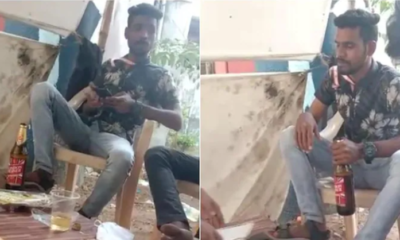Entertainment
‘Baby’ authentic take on real danger to global peace: Director

Mumbai: Neeraj Pandey’s two directorial ventures so far — “A Wednesday” and “Special Chabbis” — displayed his ability to take the language of Hindi commercial cinema into unexpected territory. He says his new film “Baby”, on terrorism, is his effort to create awareness about the existing danger to peace.
In an interview, Pandey spoke about “Baby” and the dynamics of making films on sensitive subjects.
Excerpts:
Q. “Baby” is about international terrorism. Post the ghastly terror attack in Peshawar, do you feel cinema must become more responsible in its projection of the issue?
A. Speaking for myself, I’d like to believe I’m a responsible filmmaker. I don’t have solutions. But I hope to create a renewed awareness about the situation. Any filmmaker who talks sense should be taken seriously.
Q. Your trailer tells us that “Baby” is about the efforts of a covert Indian intelligence team to nab an international terrorist?
A. The trailer had to tell us the film’s DNA. We wanted to be very clear on this.
Q. You’ve cast actors who belong to the country of the characters’ origins?
A. Yes, and that was not easy to do. Communication was difficult. What would otherwise have taken a couple of days took much longer. But having a competent casting director Vicky Sidana on board was a big help. He kept following up on all the actors from whichever country we wanted.
Q. You also shot in many foreign countries, which you haven’t done before?
A. Well, I like to travel. So it isn’t as if I’m not familiar with international locations. But travelling with a film crew is something else. The film needed to be shot in various countries. So we travelled to Delhi, then Nepal, Turkey and Abu Dhabi to shoot. The conditions were different at each location. But it was a great deal of fun and big challenge.
Q. You’ve cast a Pakistani actor as a terror mastermind. Isn’t that a clear indication of where the terror hub is?
A. Terror is prevalent everywhere in the subcontinent. Let’s not fool ourselves into believing it’s not present in India. Just the other day we had another terror attack in Bangalore. I chose the Pakistani actor Rasheed Naaz to play the main terrorist because I wanted someone with an oratorial skill, who could sway audiences into hatred and violence. There are two villains in the film — an Indian played by Kay Kay Menon and a Pakistani played by Rasheed Naaz. I wanted a particular accent in the speech in my Pakistani villain.
Q. Your earlier films generated curiosity but they didn’t create the widespread interest that “Baby” has. Does that make you nervous?
A. Not at all. When we cut our trailer and put it out, we wanted to generate interest and curiosity. And I think we managed that. We understood that it wouldn’t happen with “A Wednesday” because I was new and the trade didn’t trust my ability to generate revenues. We had cut a very interesting trailer for “A Wednesday” as well. But at that time I was not equipped to put my idea into a perspective.
Q. When you came to your second film, you were much better placed in the film mart?
A. It was slightly better during “Special Chabbis”. Budget-wise, and in terms of scale and scope my two earlier films were smaller. I feel the scale of a film must match the plot. I took ‘baby’ steps to get to my new film from where I started in “A Wednesday”.
Q. There is the danger of a big film like “Baby” being perceived by the audience as a documentation of real life terror-politics. That would limit the viewership?
A. But “Baby” is an authentic take on a very real and disturbing danger to global peace. There’s no room for flights of fancy here. It’s set in a real incident. The purpose of the film is to recreate a specific real life situation. We can’t control the take-outs from the plot. It’s up to the audience to carry home what they like. We have a very real story to tell. How it is perceived is not in our control.
Entertainment
Casino Days Reveal Internal Data on Most Popular Smartphones

International online casino Casino Days has published a report sharing their internal data on what types and brands of devices are used to play on the platform by users from the South Asian region.
Such aggregate data analyses allow the operator to optimise their website for the brands and models of devices people are actually using.
The insights gained through the research also help Casino Days tailor their services based on the better understanding of their clients and their needs.
Desktops and Tablets Lose the Battle vs Mobile
The primary data samples analysed by Casino Days reveal that mobile connections dominate the market in South Asia and are responsible for a whopping 96.6% of gaming sessions, while computers and tablets have negligible shares of 2.9% and 0.5% respectively.
The authors of the study point out that historically, playing online casino was exclusively done on computers, and attribute thе major shift to mobile that has unfolded over time to the wide spread of cheaper smartphones and mobile data plans in South Asia.
“Some of the reasons behind this massive difference in device type are affordability, technical advantages, as well as cheaper and more obtainable internet plans for mobiles than those for computers,” the researchers comment.
Xiaomi and Vivo Outperform Samsung, Apple Way Down in Rankings
Chinese brands Xiaomi and Vivo were used by 21.9% and 20.79% of Casino Days players from South Asia respectively, and together with the positioned in third place with a 18.1% share South Korean brand Samsung dominate the market among real money gamers in the region.
Cupertino, California-based Apple is way down in seventh with a user share of just 2.29%, overshadowed by Chinese brands Realme (11.43%), OPPO (11.23%), and OnePlus (4.07%).
Huawei is at the very bottom of the chart with a tiny share just below the single percent mark, trailing behind mobile devices by Motorola, Google, and Infinix.
The data on actual phone usage provided by Casino Days, even though limited to the gaming parts of the population of South Asia, paints a different picture from global statistics on smartphone shipments by vendors.
Apple and Samsung have been sharing the worldwide lead for over a decade, while current regional leader Xiaomi secured their third position globally just a couple of years ago.
Striking Android Dominance among South Asian Real Money Gaming Communities
The shifted market share patterns of the world’s top smartphone brands in South Asia observed by the Casino Days research paper reveal a striking dominance of Android devices at the expense of iOS-powered phones.
On the global level, Android enjoys a comfortable lead with a sizable 68.79% share which grows to nearly 79% when we look at the whole continent of Asia. The data on South Asian real money gaming communities suggests that Android’s dominance grows even higher and is north of the 90% mark.
Among the major factors behind these figures, the authors of the study point to the relative affordability of and greater availability of Android devices in the region, especially when manufactured locally in countries like India and Vietnam.
“And, with influencers and tech reviews putting emphasis on Android devices, the choice of mobile phone brand and OS becomes easy; Android has a much wider range of products and caters to the Asian online casino market in ways that Apple can’t due to technical limitations,” the researchers add.
The far better integration achieved by Google Pay compared to its counterpart Apple Pay has also played a crucial role in shaping the existing smartphone market trends.
Content provided by Adverloom

























